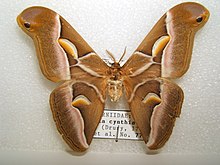bio.wikisort.org - Animal
Samia cynthia, the ailanthus silkmoth, is a saturniid moth, used to produce silk fabric but not as domesticated as the silkworm, Bombyx mori. The moth has very large wings of 113–125 mm (4.4–4.9 in), with a quarter-moon shaped spot on both the upper and lower wings, whitish and yellow stripes and brown background. There are eyespots on the outer forewings. The species was first described by Dru Drury in 1773.
Eri silk


The common name, ailanthus silkmoth, refers to the host plant Ailanthus. There is a subspecies, S. cynthia ricini in India and Thailand that feeds upon the leaves of castor bean, and is known for the production of eri silk, and is often referred to by the common name eri silkmoth.
The eri silk worm is the only completely domesticated silkworm other than Bombyx mori. The silk is extremely durable, but cannot be easily reeled off the cocoon and is thus spun like cotton or wool.[1]

Range
Peigler & Naumann (2003),[2] in their revision of the genus Samia, listed material of true Samia cynthia examined as follows:
Indigenous populations
- Asia: China (Zhejiang, Shanghai, Jiangxi, Jiangsu, Shandong, Beijing, Shanxi, Liaoning, Heilongjiang); Korea (North Pyongan, South Pyongan, Pyongyang, Kangwon, South Kyongsan, Chungcheongnam-do province)
Introduced populations
These include moths that have escaped from cultivation or were introduced and naturalized:
- Asia: Japan; India; Thailand[3]
- Australasia: Australia
- America: Canada; United States; Venezuela; Uruguay; Brazil
- Africa: Tunisia
- Europe: France; Austria; Switzerland; Germany; Spain; Bulgaria; Italy
Life cycle


Eggs
Whitish eggs, marked with brown, are laid in rows of 10 to 20 on leaves in crescents. Hatching takes 7 to 10 days.
Larvae
Larvae are gregarious and yellow at first. Later instars are solitary, and whitish green with white tubercules along the back, and small black dots. There are five instars, and they reach a maximum length 70–75 mm (2.8–3.0 in).
Pupae

A silken off-white to grey cocoon is spun on the leaves of the host. It has an obvious escape hatch.
Adults
Females prepare to mate in the evening or night after emerging in late morning. Adult flight is during May and June in northern Europe, as one generation. In southern Europe a partial second generation may occur in September. Adults lack mouth parts and can neither eat nor drink.
Food plants
Larvae will feed on other trees and shrubs, but all eggs are laid on the "tree of heaven" (Ailanthus altissima) and growth is best on it. This tree is commonly grown as an ornamental in cities, but is considered a noxious weed and vigorous invasive species and is one of the worst invasive plant species in Europe and North America.[4] The subspecies S. cynthia ricini feeds upon castor bean.
See also
- Sericulture
References
- "The Queen of Textiles." Nina Hyde. National Geographic Magazine. Vol. 165, No. 1, January, 1984, pp. 2-49.
- Peigler, R.S. & Naumann, S., 2003. A Revision of the Silkmoth Genus Samia. San Antonio: University of the Incarnate Word. 230 pp., 10 maps, 228 figs. ISBN 0-9728266-0-2
- Wangkiat, Paritta (19 February 2017). "Ericulture reeling them in". Bangkok Post. Retrieved 19 February 2017.
- Sladonja, Barbara; Sušek, Marta; Guillermic, Julia (October 2015). "Review on invasive tree of heaven (Ailanthus altissima (Mill.) Swingle) conflicting values: assessment of its ecosystem services and potential biological threat". Environmental Management. 56 (4): 1009–1034. Bibcode:2015EnMan..56.1009S. doi:10.1007/s00267-015-0546-5. PMID 26071766. S2CID 8550327.
Further reading
- Tuskes, PM, JP Tuttle and MM Collins. 1996. The Wild Silk Moths of North America. Cornell University Press. ISBN 0-8014-3130-1
- Saturnids of Western Palearctic
External links
| Wikispecies has information related to Samia cynthia. |
| Wikimedia Commons has media related to Samia cynthia. |
- Lotts, Kelly & Naberhaus, Thomas (2017). "Ailanthus silkmoth Samia cynthia (Drury, 1773)". Butterflies and Moths of North America. Retrieved November 11, 2018.
- Cynthia moth (Samia cynthia) mating (YouTube video).
- Cynthia moth (Samia cynthia) laying eggs (YouTube video).
- Lepiforum e. V.
На других языках
- [en] Samia cynthia
[es] Samia cynthia
La mariposa de seda del Ailanto (Samia cynthia) es una especie de Lepidoptera (un heterócero) que produce un tipo de seda. Esta especie se alimenta de hojas de árboles del género Ailanthus, Ricinus o Ligustrum.[it] Samia cynthia
Il bombice dell'ailanto o filosamia (Samia cynthia (Drury, 1773)) è un lepidottero appartenente alla famiglia Saturniidae, originario dell'estremo Oriente (regioni asiatiche della Russia, Cina, Giappone), ma introdotto anche in Europa, Nordafrica, Medio Oriente e America settentrionale.[1][ru] Айлантовый шелкопряд
Айла́нтовый шелкопря́д[1] (лат. Samia cynthia) — вид павлиноглазок из подсемейства Arsenurinae. Гусеницы используются человеком для получения шёлка, но не является одомашненным видом, как тутовый шелкопряд (Bombyx mori).Другой контент может иметь иную лицензию. Перед использованием материалов сайта WikiSort.org внимательно изучите правила лицензирования конкретных элементов наполнения сайта.
WikiSort.org - проект по пересортировке и дополнению контента Википедии

